Interview
Becci Spruill: Into the Wild
“Into the Wild” is a regular interview with early career print artists. Interviews will highlight the varied paths the subjects are taking to strike an accord between life and their artistic practice. Expect a balance of approaches, from those hopping the residency circuit, to those teaching part-time or who snagged the elusive tenure-track gig right out of the gate, or those working a desk job or waiting tables to afford access to a community print shop or maker space. In short, there’s many ways to “make it” and we want to share them all!
Have an idea for a person to interview? Please submit suggestions to the Interviews section of the Submissions portal below.
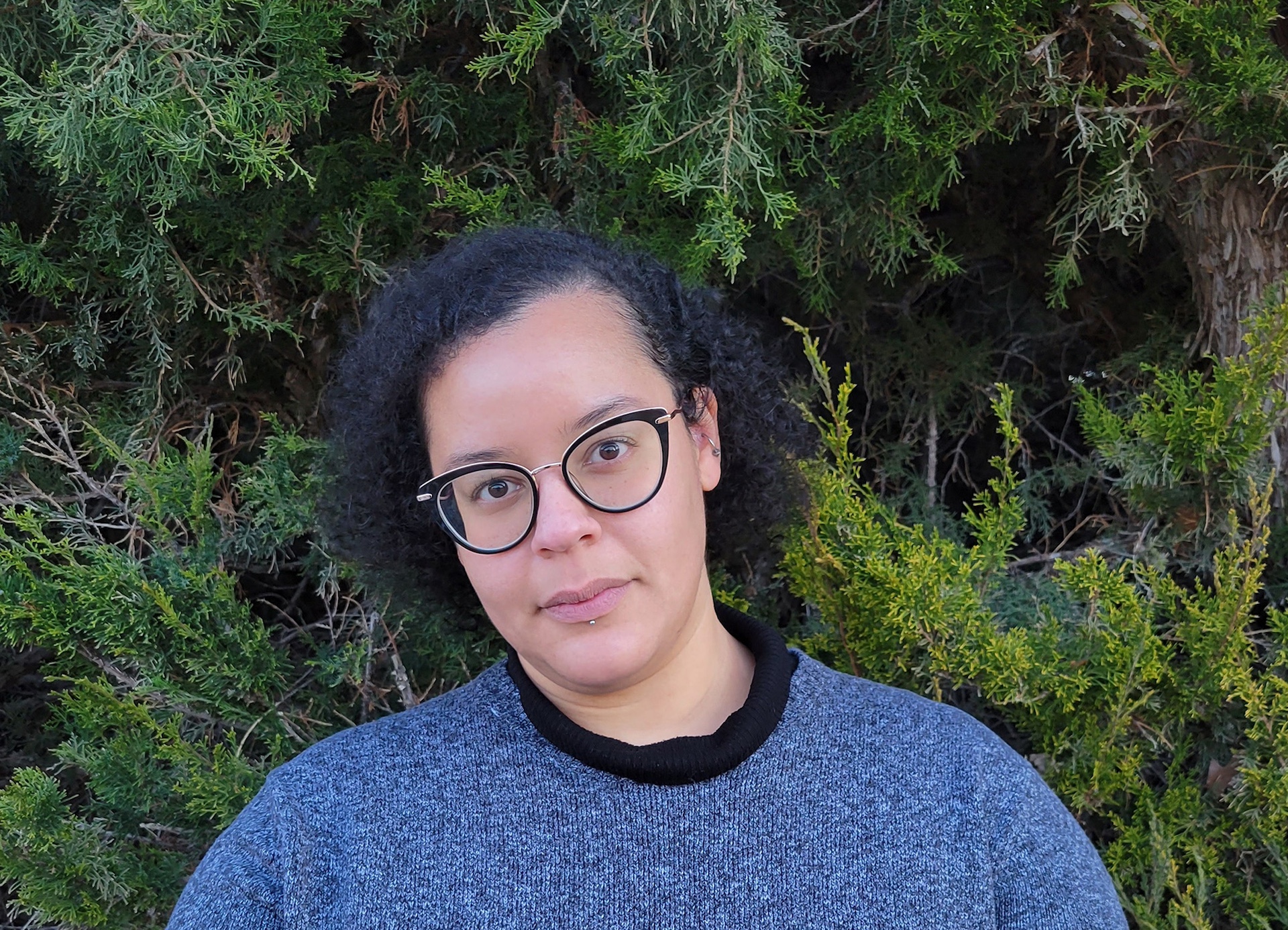
Becci Spruill
Becci Spruill is the Assistant Professor of Creative and Fine Arts at the New Mexico Institute of Mining and Technology. She’s originally from North Carolina, where she earned her Sociology and Fine Art degrees. She received her MFA in Printmaking at Kansas State University. She is the co-founder of the Radical Intersectional Printmakers’ Guild and current Vice President of the Mid-America Print Council. She has organized and juried multiple exhibitions and panels that work to expand opportunities for historically underfunded and underrepresented artists in the field of printmaking. Her current research interests include the intersection of traditional and digital processes, as well as the socio-historical impacts on perceptions feminine bodies.
Artist Statement:
Rebecca (Becci) Spruill is an interdisciplinary printmaker whose work currently explores her experiences with disordered eating, body dysmorphia and internalized colonial beauty standards and societal norms. Her work is produced through obsessive and redundant processes that mimic her fixation on the perception of her body.
She is inspired by and sometimes appropriates compositions from Western art history and the visual media of her childhood, including hip-hop music videos and Japanese manga. These compositions frame short narratives of moments in which she feels unideal. In these vignettes, she relies on humor and the absurd as a method of critiquing and subverting the expectations of the femme body as an object. Humor also creates an informal relationship with her work, encouraging a sense of empathy that can hopefully be extended to the viewer’s relationship with themselves.
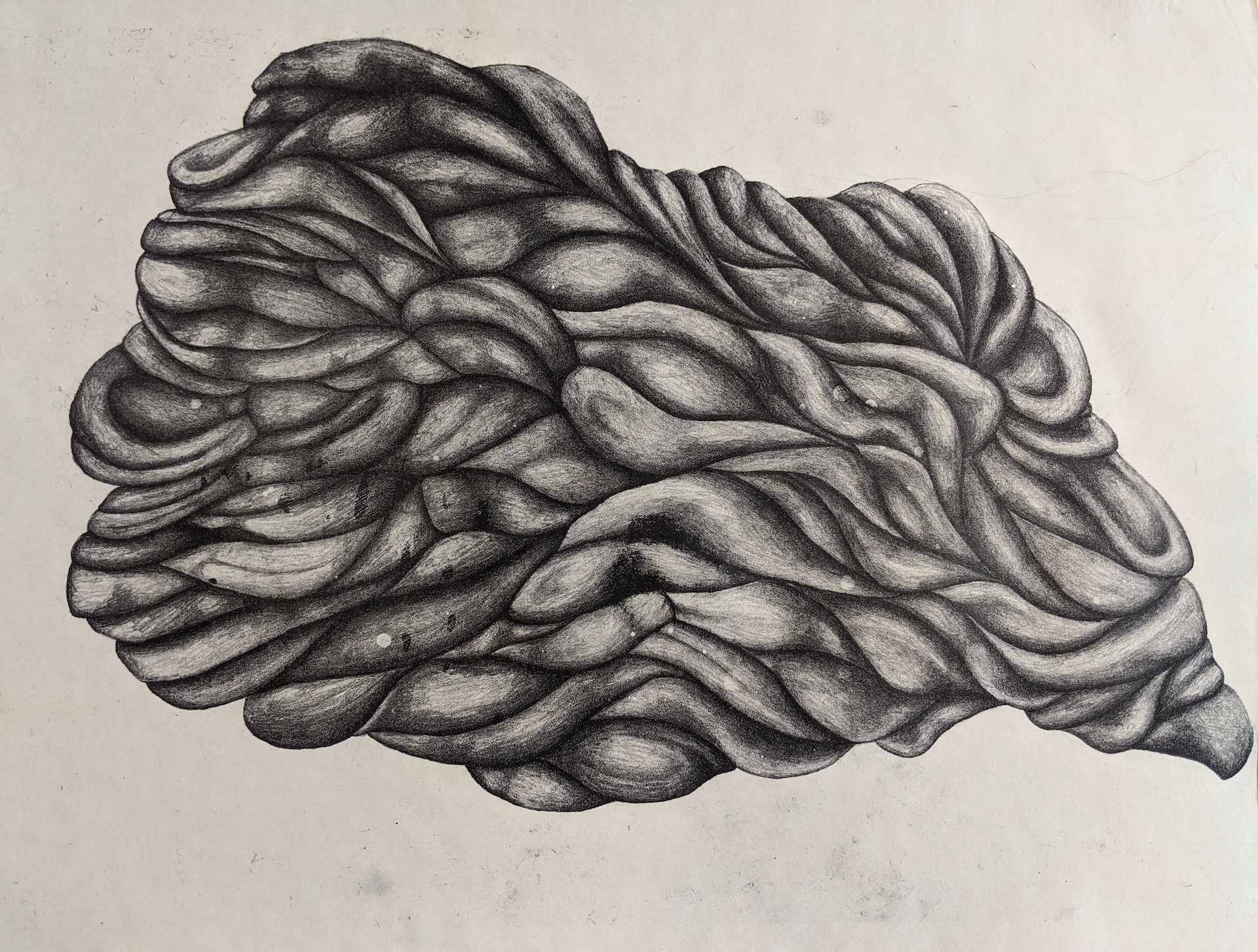
Untitled
Lithograph with chine collé
18″ x 24”
2017
The Interview
Blake Sanders: You attended undergrad at University of North Carolina at Pembroke. We met, in fact, at Pembroke when Hannah and I were there for a visiting artist gig. What brought you to Pembroke? Was art always the plan? When did you discover the printmaking program, and how did it introduce you to the broader printmaking community?
Becci Spruill: Actually, I had a pretty rough time in high school. The reason I went to college was because of my high school art teacher, Mrs. Aker. I was a pretty feral teenager, in retrospect. I spent a good deal of time in school with undiagnosed ADHD and found school pretty boring, since it wasn’t particularly difficult for me to read a book and take a test. I told my art teacher that once, and she ‘conspired’ with my German teacher (Frau Davis) to get me placed in AP and Honors courses. They also created a system where all my teachers reported my attendance to each other. If I skipped any classes, I wouldn’t be allowed to participate in art or German classes – the only two I regularly attended! Honestly, I owe a lot of my life to those two for putting in the extra effort and just generally believing in me. I decided to go to college because Mrs. Aker actually inspired me to pursue Art Therapy – she was a certified art therapist – and when it came time to apply to colleges, UNC Pembroke was one of few that would take a chance on me! I’m quite glad they did, because I got to learn a lot more about the world and find things that were challenging for me – printmaking and sociology being the two subjects that really stole my interest.
My first high school art teacher, Mrs. Harrell, was a printmaker and I really enjoyed the plexiglass monotypes we made in her class. I was excited to take my first college printmaking class with Brandon Sanderson, and really loved the integration of science and art that is inescapable in this field. I took intermediate printmaking, and after Brandon presented the projects for the year, I stayed after to ask him how flexible those projects were. I believe I said something along the lines of, “How can I do what I want to do?” – haha. Despite my brusqueness, he was open to me exploring my own interests – as long as I wrote proposals for the projects. After that, I was involved in several visiting artist workshops – where I met you and Hannah, as well as Meghan O’Connor, Andrew Kosten, Nathan Pietrykowski, Robyn Wall, Amanda James-Martin – a ton of people, frankly. All of the visiting artists were very influential to me, some in more visible ways than others. Working with everyone really helped me realize there were always new processes to try, new ways to improve my prints, and new things to learn. I also went to a few SGCI conferences while I was in undergrad, and while my experiences were a mixed bag, they ultimately encouraged me to keep pursuing print.
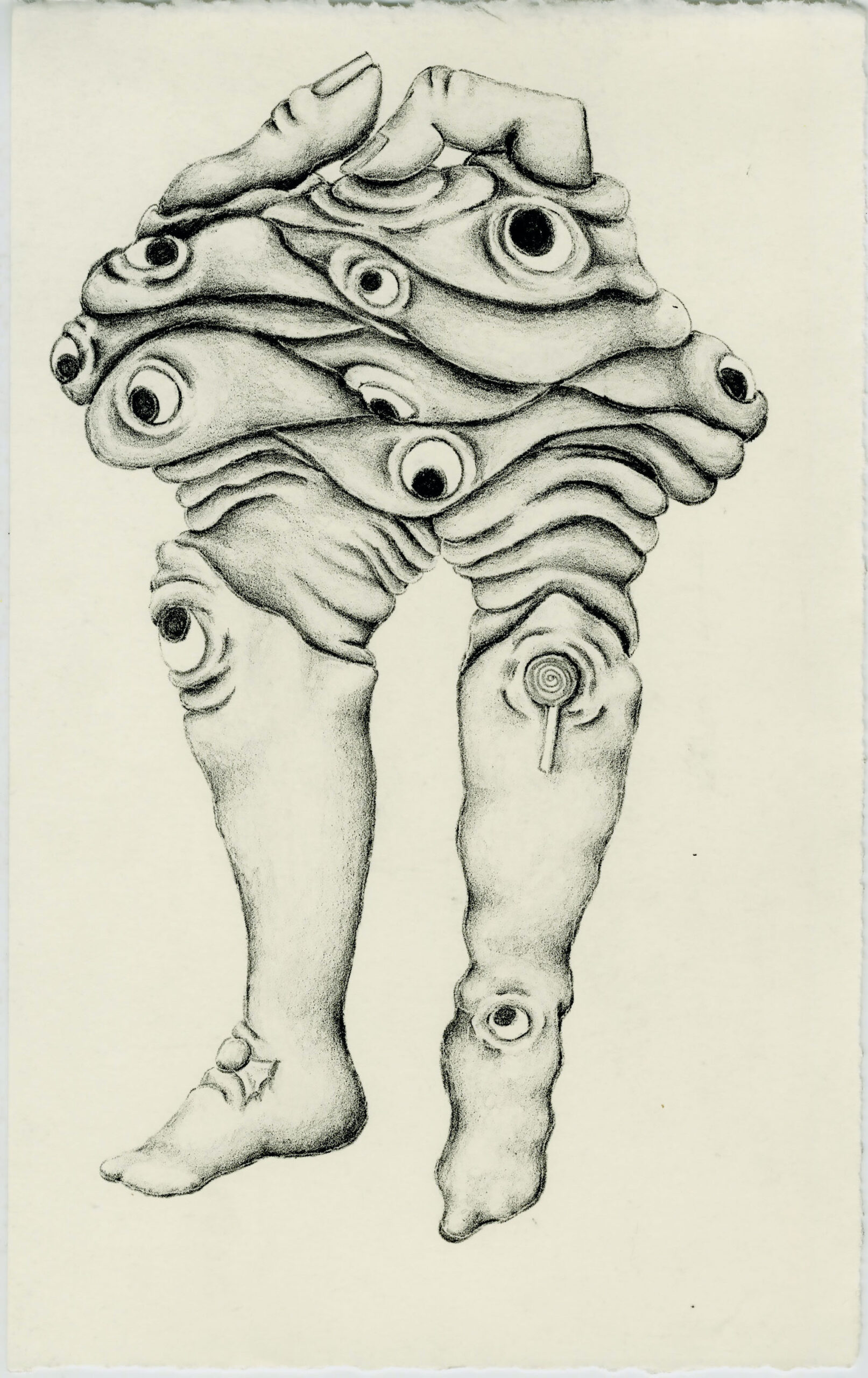
Kinky Boots
Lithograph
8″ x 10”
2017
B: You earned your MFA from Kansas State with Jason Scuilla. What drew you to Manhattan? How did the rather technical underpinnings of the program affect your work? How did the Midwest setting/culture/demographics contrast with growing up in NC? How do you feel the graduate experience prepared you for entering a creative career?
BS: I wish I had a better answer to this! I actually applied to grad schools based on what I could afford, and how far away from home I could afford to travel. I come from a single parent household, so if I couldn’t get nearly all of my schooling funded I simply wasn’t going to grad school. So, K-State’s support for their grad students was particularly appealing. They also billed themselves as interdisciplinary. I had two degrees that were intersecting in interesting ways, and I wanted to study somewhere that supported those explorations, while also letting me take sociology courses at higher levels.
Culturally, Kansas was a shock. I came from a school that is a historically Indigenous college with a very high level of diversity, and that was definitely not what K-State was. I remain unimpressed by the experiences I had there as a woman of color, but those negative experiences ignited a desire to talk about my own lived experiences and perspectives. It also made my feelings of being unideal worse. I actually had a pretty bad eating disorder when I got there, and my body dysmorphia and disordered eating got worse in the first few months I was in Kansas. Some of that was related to being one of a handful of people of color in my department and having a body that is very much influenced by my ancestors; my height, weight and propensity to add muscle instead of losing fat are all very much in line with the Black side of my family. Anyway, I got to the point that my disordered eating was impacting my ability to focus in the studio – and I refused to let my work suffer, of course, so I started to go to therapy. While it may not sound positive, in the end I started making work about myself and allowing myself to be a bit more intuitive with my drawing, which Jason supported.
Another thing I got from being at K-State is the ability to collaborate; the program was really good at encouraging us to explore a variety of topics, even if they were outside of the expertise of our area professors. You can see that in the work Jason, Stefan and Katrin Bossman have done with electrolytic etching. I read a lot and spent a good deal of time discussing my work with the chair of the Gender, Women & Sexuality Studies program at K-State, as well as exploring the technical aspects of printmaking with Jason. I got to explore more technological intersections, particularly in using the CNC router and laser engraver to produce large-scale work (usually 4-5 feet tall). Funnily enough, I actually hated engraving when I first got to K-State; it felt like I was too divorced from the end product, and I preferred what I consider the consistent intimacy of litho. Studying with Jason, I actually developed an affection for it.
Something else that helped me prepare for the academic route were my three years as a graduate teaching assistant – we were, effectively, instructors of record at K-State. We received a syllabus and shadowed another professor our first semester, but after that we were the main instructor in the room. While this is a divisive practice in higher education, and rightfully so, I had already decided I wanted to be a professor in the future. In the years since, I’ve seen how that early experience in the classroom really helped me develop my own pedagogy at an early stage.
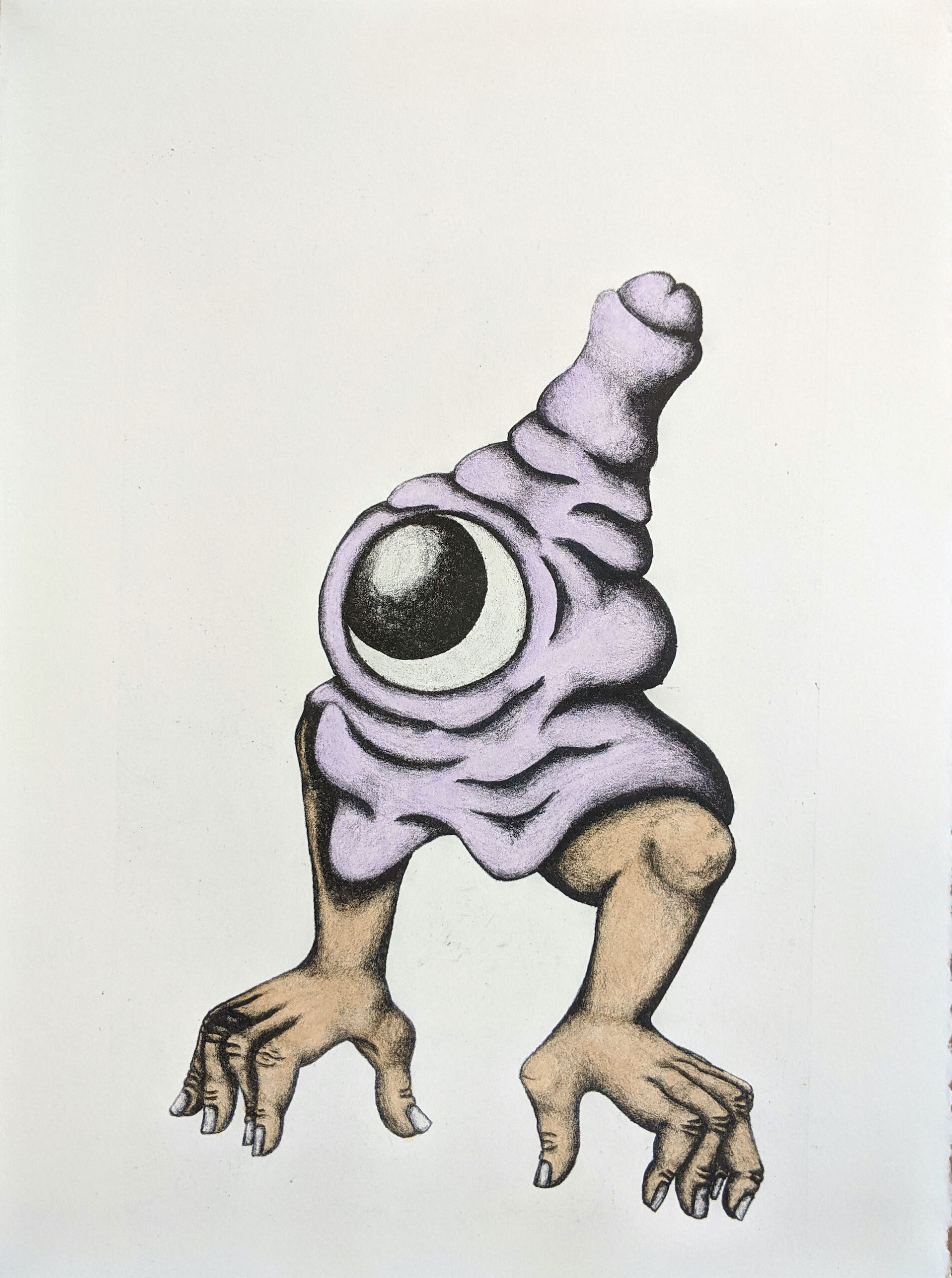
Dickhead
Hand-painted lithograph
11″ x 15”
2017-18
B: The MAPC conference at KSU is just a couple days away at the time of publication. You’ll be chairing a panel called Ink and Algorithms. Can you give us a brief peak at what to expect from the panel? As a KSU alum and a current MAPC Board member, care to provide a preview of what we have to look forward to in Manhattan, for those of us that can make it?
BS: We’ll be exploring the ever developing status and impact of artificial intelligence and machine learning on the field of fine art and taking a close look at how these technologies could and do impact printmaking and printmakers. There will be discussion of theory, historical perspectives, the way AI can be used as a tool in the classroom, and how AI influences the work of printmakers while exploring the concept of the author. I’ll also talk briefly about the anti-colonial potential for AI. It’ll be an interesting talk, I think – everyone on the panel has really interesting perspectives. I’m not particularly interested in telling people what to think about the morality of AI – but it’s happening now, and it will have indelible impacts on the world of images.
Manhattan is an interesting place; the campus is relatively small, as is the town, so hopefully it will be an accessible conference. I tore several ligaments while I was there and was often still able to traverse the space on crutches – but make sure you follow the signs for elevators! They’re not in intuitive spaces at all, I’m afraid.
I’m on the Diversity, Equity, Inclusion and Access committee in MAPC, and we’re looking forward to having microphones at demonstrations and offering an Accessibility workshop for presenters on September 20th – keep an eye out for more info soon through our instagram and mailing list. As a board member of MAPC, I’ll also say we’re quite optimistic about the Silent Auction – we’ve used the previous Silent Auction funds to offer 15 mini grants to conference presenters, as well as help feed students at the conference. We’re hopeful the Silent Auction will generate even more funds for us to make conference attendance more equitable in the future.
K-State has also changed a lot since I was there – I recommend people take the time to tour their library’s makerspace, which is open to the community as well as students. I’m quite excited for several of the panels and demonstrations – particularly Death and the Printed Object and Everything Is Ink – though I also hope I’ll somehow have time to catch the Ink Making Demo, Ashes to Ink. There’s also a bar district that’s walking distance from campus, if that’s interesting to you – and if it’s still open, there’s a food truck that will sell you a fistful of bacon in the middle of the night, haha. I’m looking forward to seeing some of my old friends again, meeting new people, and having another impromptu gathering of RIPG members! If you see me around, come over and say hi (I love to “yap”, as my students call it).
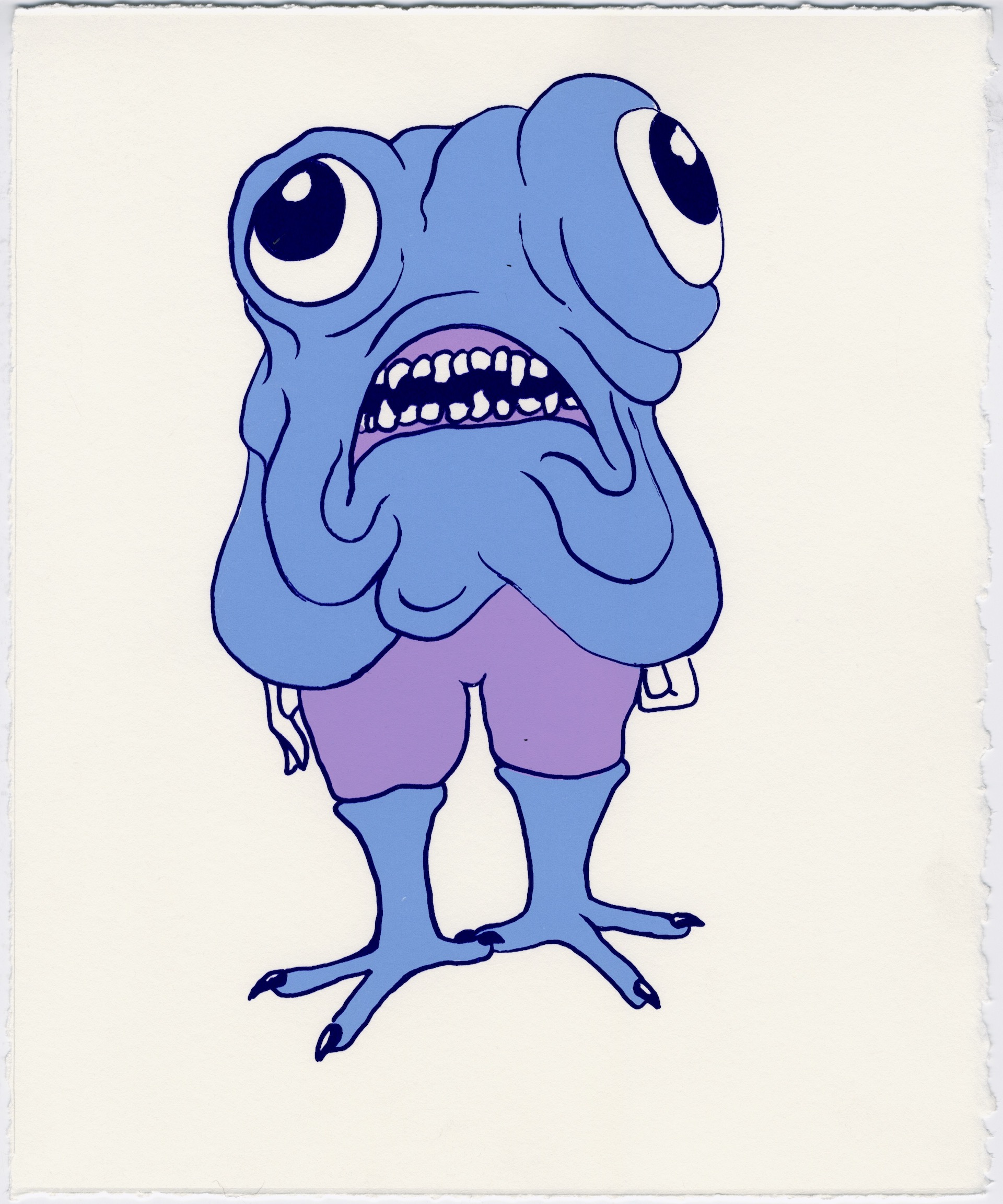
Oh…
Screenprint
11″ x 15”
2018
B: You are currently the Assistant Professor of Creative and Fine Arts at New Mexico Institute of Mining and Technology. It looks as if you teach in a variety of mediums and subjects. How did your background in printmaking prepare you for the flexibility necessary for your role?
BS: Yes – I teach a lot of different things. They include video game design (specifically art & assets), graphic design, social media and branding, app design, art history and book arts – this semester is actually the first semester I’ll be teaching printmaking, somehow!
I’ve always been open to any media; although I, admittedly, have a bad habit of looking at everything to see if I can take it and mold it in service of printmaking. It’s hard not to think like a printmaker! Because of this, a lot of my work involves principles of character design from video games and animation, and refers to some art historical images and poses. I’ve always been a huge nerd for art history. Hopefully sometime soon I’ll find time to get a doctorate in that field.
But I’m not answering your question well; from my perspective, printmaking is the beginning of making art for the masses. In that way, graphic design, video games, app design and animation are all connected to this fascinating history of technological development in pursuit of reaching more people with art. I find it really interesting to use those tools, several generations removed from printmaking, to return to and develop the practice and process of origin.
Making art for the communities I’m a part of is really important to me; it’s actually part of why I was so drawn into printmaking. I like painting and drawing, but I couldn’t imagine asking anyone to pay me that much for one thing, haha. The ability to make multiples means more people get to experience art, to have it in their houses and make it part of their daily lives. I grew up in poor communities of color that didn’t really get to see art that frequently, though I did see a lot of prison artwork. In fact, my family and their friends really valued the pursuit of art, though there were a fair share of people who bullied me for “acting white”. I don’t think making or seeing art should be seen as something that can be gatekept. So for me, making art that can be seen by the same community members I grew up with, that my mom could afford when we were kids, is really important.
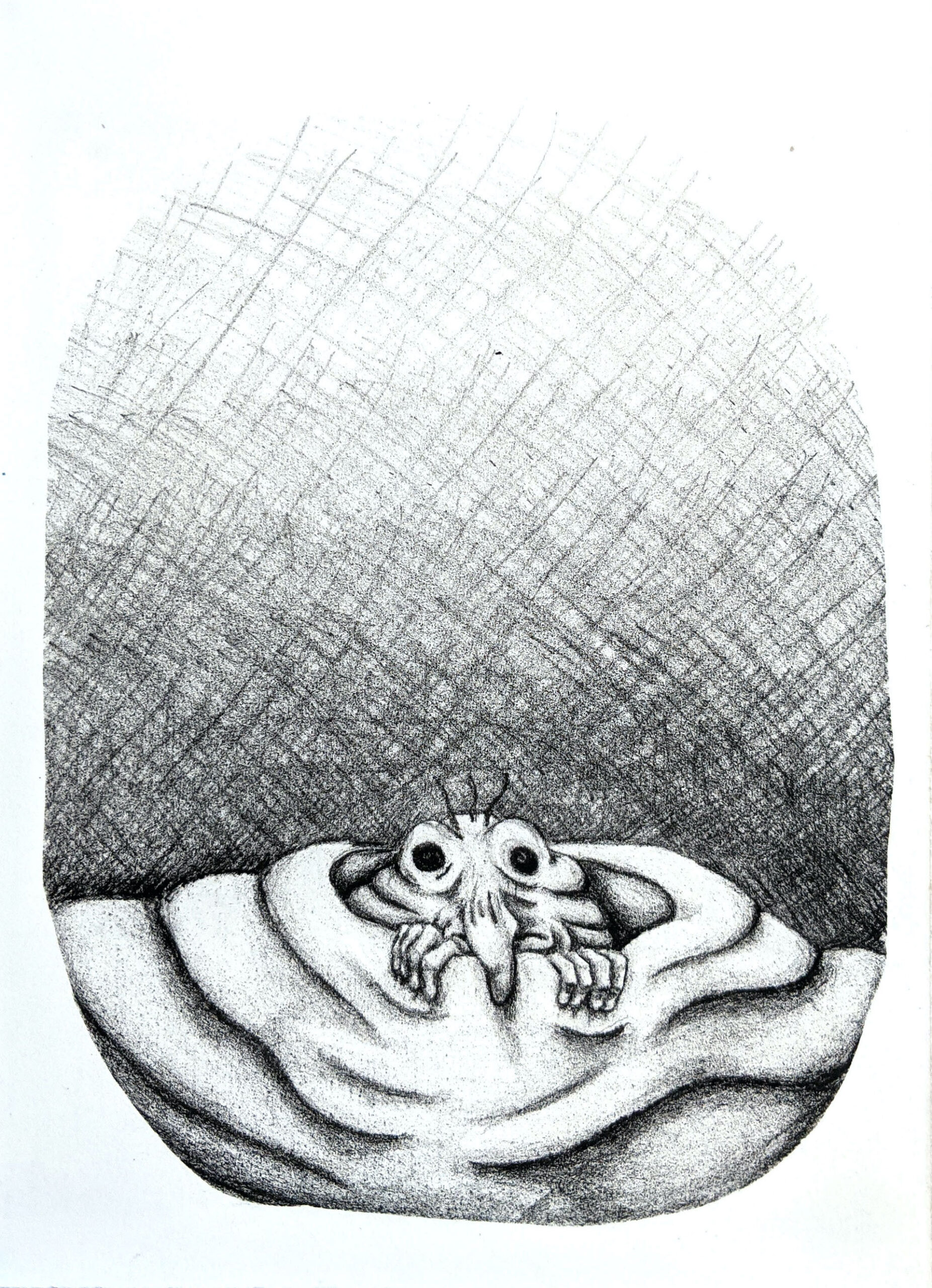
Low Days
Lithograph
8″ x 10”
2018

Look Back At It
Screenprint
11″ x 15”
2019
B: What is your current studio practice like? Do you have a space at home dedicated to making? Are you working in the studios at school regularly as well? How does studio time/access affect your work/home/relationship balance?
BS: I’m actually pretty lucky to have a dedicated studio on campus – it’s relatively small, but it’s mighty! It’s technically my personal studio, and it’s actually a converted air quality lab in our chemistry building. Most of the material – including the Conrad combination press – were bought through a startup fund tied to the individual professor’s position at my institution. Currently the studio is set up to do relief and traditional etching, but hopefully it’ll be set up for lithography soon as well.
I’m also teaching in the space, and I’m really lucky to have great students with real interest in printmaking as both an art and a science. I spend about four extra hours a week in the studio to host their studio hours, which also really helps my productivity stabilize in the middle of us moving into a new house. In the future, there are some plans at my university to update a larger room for printmaking – so hopefully we’ll be able to get a larger press in the next few years.

UnIdeals
Installation view
MDF, acrylic ink, Velcro, oil-based ink
Figures are between approx 4.5’ – 6’ tall
2018-2019
B: A foundation of your work is anxiety and disorder about the femme body. It often features repetitive, textured mark-making and cultural references. How has this work developed over time, especially as your philosophy and career has become increasingly intersectional?
BS: I talked briefly about this before, but I had an eating disorder by the time I finished undergrad. With that came a lot of obsessive thought patterns about my body and food. At the same time, I had some massive art block (probably because I was hungry, in retrospect) and was only really drawing these blob-like formations. This was my second semester of grad school, if I remember correctly. I was feeling pretty discouraged, and had a conversation with Jason about how I “couldn’t draw” – and he asked to see the weird little doodles I was making. He reminded me that doodles are drawings too, so I started working with them more.
I got into therapy and started thinking about how strange it was that curvilinear forms were so appealing to me everywhere but my own body, and things just kinda clicked from there. I’ve always had a lot of sympathy for monsters (very few monsters ever ask to be made monsters), and started exploring the idea of a monster as an allegorical grotesque for my body dysmorphia. The repetitive marks were related very literally to my obsessive thought patterns, as well as the process of socialization. Around that time in therapy I realized those thoughts weren’t actually my own – they came from the things the people around me said to me, all throughout my childhood. I mean really – why should a five year old care what’s ladylike? Why did I learn that stripes would make me look fatter when I was seven?
Around that point I realized how ridiculous a lot of these social expectations were; I was learning a lot in the GWSS courses I had, and how subjective and historical socialization can be. Simultaneously, I was interested in the idea of the human body trying to be inhuman. That was, essentially, what I was trying to do to myself – control the humanity out of myself and act against my biology, alienating myself from my body. In response, I started using more “alienating” processes that required repetition. My work would start as a drawing and then be interpreted into vectors by Adobe Illustrator – then interpreted again by the CNC router or the exposure unit. That’s also when I started to develop an affection for etching – that feeling of alienation I had before suddenly seemed really natural. So my thesis show was a bunch of hulking CNC routed sculptures, styled like paper dolls, alongside several etchings and screenprints of moments when I felt the most unideal.
Covid hit just after grad school, and I lost access to anything but my own hands. So I kept drawing these obsessive textures on my grotesques, but I also started reflecting on the people who helped me while I was fighting to get better. My now husband, who spent most of grad school trying to get me to eat and treat myself like a human being (and semi-unwillingly assisting me in the studio, haha), my friends and even people who felt like the work spoke to their own experiences and felt sympathy for my monsters. So my monsters got a little more social, a little less isolated.
I think at this point, I may be getting ready to let go of these particular monsters, which is a bit scary. I’ve been pretty stable with my mental illness, and I’m at a point where those repetitive thoughts are less and less frequent. I don’t know if that means I’ll never make them again – I’m sure they’ll be with me forever – but there are some new things I’m excited to explore.
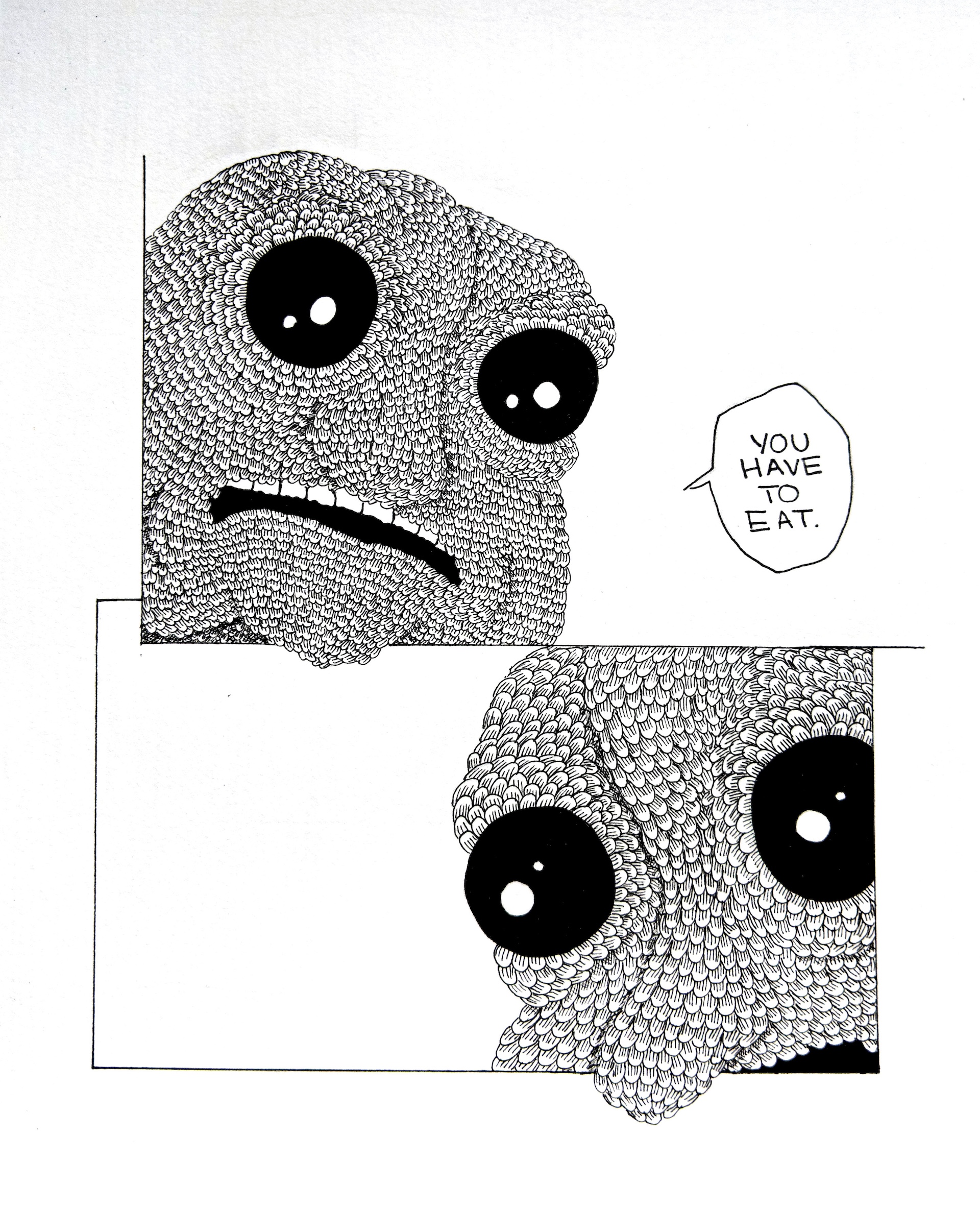
You Have to Eat
Drawing
8″ x 10”
2021
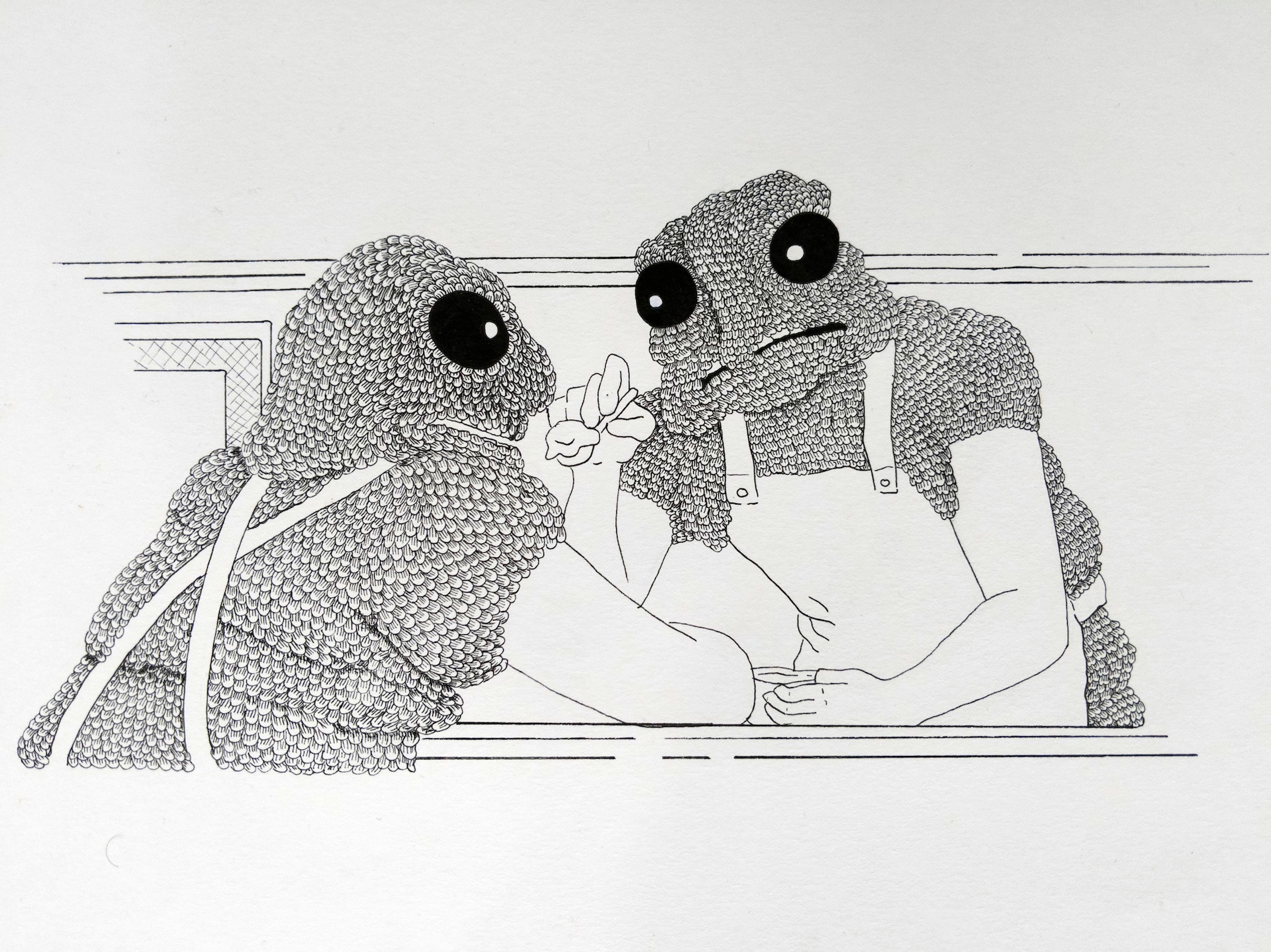
Just Eat It
Drawing
11″ x 15”
2021
B: You’re a founding member of the Radical Intersectional Printmaker’s Guild. Could you share how the organization came together? What is your mission/goals for the Guild? How can folx join and help? How has your work with RIPG helped you develop the inclusive voice and mission we see in the panels and other professional work we’ve seen from you in recent years?
BS: A friend of mine, Olivia Richardson, formed RIPG during Covid. We were talking to each other about a letter sent out by SGCI after the murder of George Floyd. At that point, I had been a member of SGCI on and off for about five years – long enough to have made some observations about the lack of diversity in board members, and the lack of effective equity- and access-based initiatives and community for people like us. That letter itself was a catalyst for a lot of people, and in our case, we realized we wanted to create a community that was started with equity and access as their driving force.
It’s been a really great experience. We’ve been able to have a lot of different opportunities for our members. Our membership is largely made up of people who identify with being disabled, LGBTQIA2S+, people of color, Black, immigrants, and/or femmes, so it’s been really good to be able to produce several opportunities for people who, like myself, are historically underrepresented. We’ve organized two member exhibitions so far, two years apart – the first at WVU and the second at MTSU. Thanks to both Joe Lupo and Nick Satinover for their help coordinating those! We’ve also hosted a few informal in-person meetups at other conferences, organized a panel at MAPC, and built ourselves a website. We’re always working on future programming! If anyone is interested in working with the Guild for our next biannual exhibit, send an email to us at riprintguild@gmail.com.
In addition, our fantastic group of volunteers have developed a lot of programming just for members – for instance, Tanushree runs our email newsletter. She researches job and exhibition opportunities herself and sends them out to our members. She and Hannah also work on our Instagram, serving up printmaking tips and tricks and sharing opportunities that our members send us or that we stumble across. Emma is a fantastic person who helps organize our exhibition opportunities, updates the mailing list and so many other things, and Edie helped me build the website. A group of our members, including Chelsea Clarke, wrote the by-laws themselves, and members voted to ratify them. Everything we do is done as collaboratively as it can be.
Right now our main goal is incorporation; it’s been the goal for a few years, honestly. We’ve finally raised enough money to pay for both filing the paperwork and having some legal advice on our bylaws. Right now we’re re-scaling the by-laws, since the number of volunteers has been consistently pretty small, and we initially wrote by-laws anticipating a higher volume of participation. Hopefully by the end of the calendar year, we’ll be incorporated. Then my next goal is to hand off leadership to someone else, to see what the Guild becomes in their hands.
If anyone’s interested in joining the Guild, it’s currently free! Just add us on Instagram and sign up for our email newsletter. Once we’re incorporated, we hope to have pay-what-you-can membership dues to keep membership accessible. If anyone is interested in working with the guild, having us promote your printmaking opportunities, or volunteering, just send us an email at riprintguild@gmail.com.
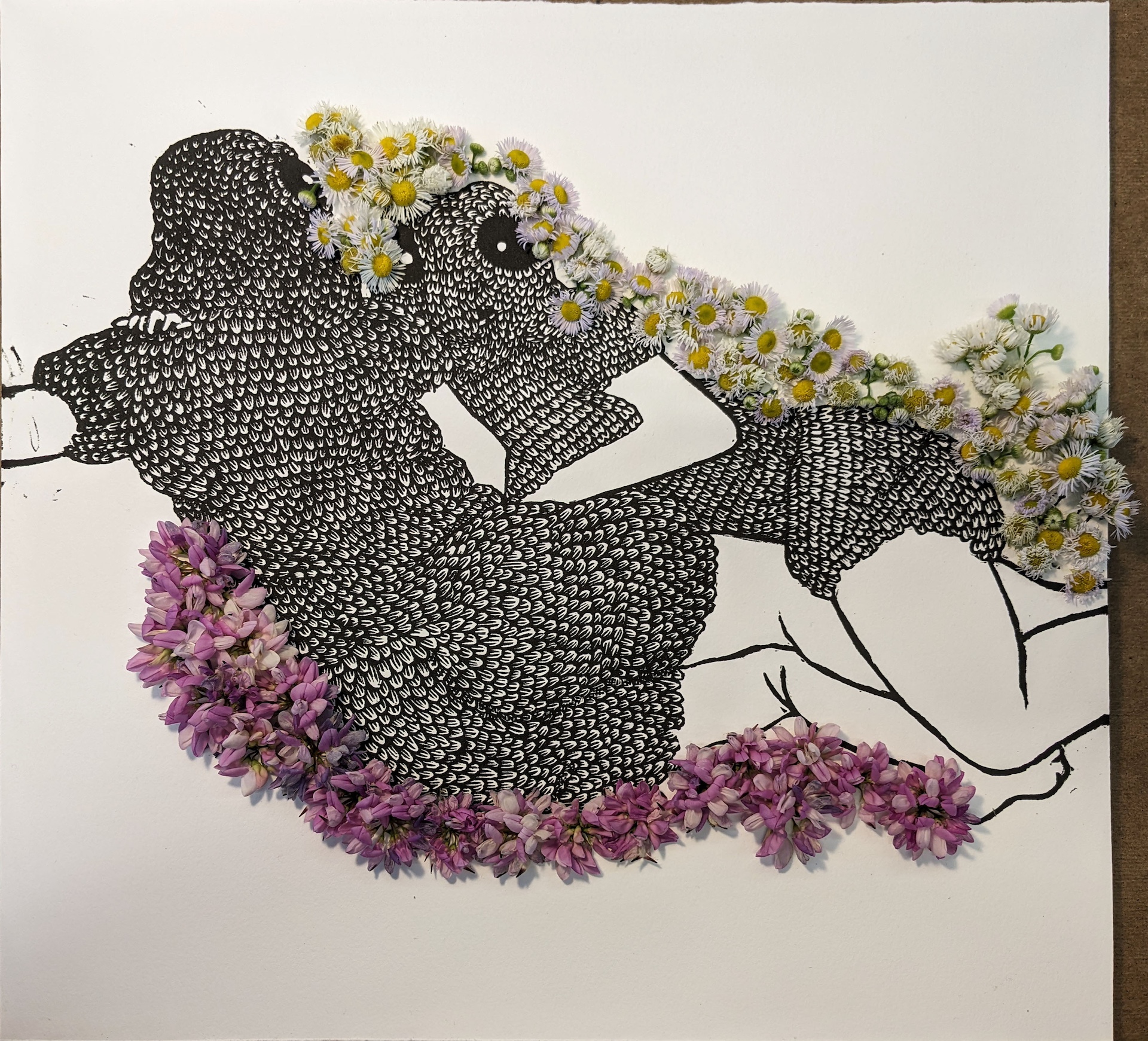
And They Were Roommates…
Linocut
11″ x 12”
2023
B: Where do you see your work and life developing in the next few years? I know you’re a brand new homeowner, that’s a big development! What does success look like for you?
BS: I think stability is probably a big way that I would define success – but that’s more of a personal metric, I guess. I grew up without a lot, so that’s probably shaped my definition of success. I’ve always wanted to own a home, to have a steady income, have good friends, and to have the ability to travel and meet new people, so I feel pretty proud of myself right now, haha. I think my next goal is probably finding more ways to get involved with my immediate, New Mexico community through art and education and maybe setting up a home studio.
Professionally, success – to me – comes with the ability to bring more people like me into printmaking, design and academia – to give more people the agency, ability and knowledge to define the way the world looks. It’s not easy to break into fields like these without support from communities that understand your experiences, so I’m really glad that I’ve been able to help my students create organizations like the Society for Hispanic Professional Engineers, the Hispanic Student Association, and a chapter of the Black Student Union at my current university. I’m very proud of all of them for persisting in an institution that wasn’t built with them in mind. I’m also really happy to have had the opportunity to form RIPG with Olivia, to work with our absolutely stellar volunteers, and to be on the board of MAPC.
And of course – success means making! I’m looking forward to some new collaborations with a few of my friends and colleagues, and the ability to make more work – monsters or otherwise.

Booger Buns
Etching
15″x20”
2019
B: What advice would you give current students as they’re about to journey into the wild? What do you wish you’d been told or prepared for by your educational experience or print institutions like SGCI?
BS: I guess I would start with this – you aren’t alone. The world can be a lot more collaborative than it is competitive, if you know where to look. Take as many opportunities to meet new people in the field as you can, and approach the world with community in mind. Be flexible and open in the ways you want to grow, and see what happens.
It’s tough going out in the world, it’s tough getting rejected, but that doesn’t mean you aren’t a good printmaker or someone with potential. It just means that whoever juried that opportunity or did the hiring for that job, wasn’t looking for you in that particular moment.
And I’ll end with this – always remember what your own goals are. Protect your energy – if something isn’t nourishing you, it’s okay to step away from it. Success isn’t built on obligation and burnout! It’s easy to get swept into what people think you should want – fame, wealth, gallery representation, and all those traditional, historically gate kept markers of success. And if you want those things – work! Get it! I’ll be rooting for you!
But life is as short as it is long, so always keep in mind – how can you do what you want to do?
